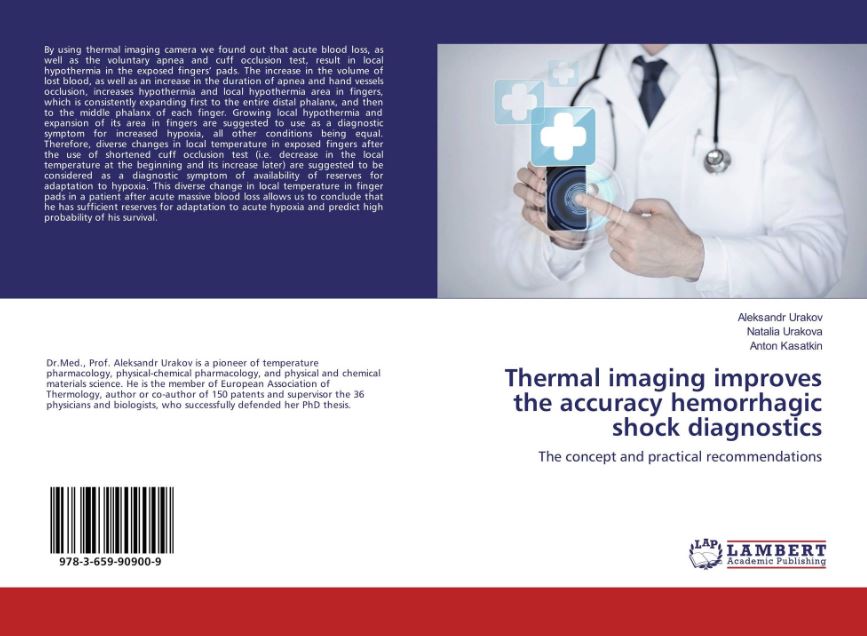
L международная выставка-презентация
научных, технических, учебно-методических и литературно-художественных изданий
Thermal imaging improves the accuracy hemorrhagic shock diagnostics. The concept and practical recommendations

| Группа | Научная литература |
|---|---|
| Название на русском языке | Thermal imaging improves the accuracy hemorrhagic shock diagnostics. The concept and practical recommendations |
| Авторы на русском языке | Aleksandr Urakov, Natalia Urakova, Anton Kasatkin |
| Название на английском языке | Thermal imaging improves the accuracy hemorrhagic shock diagnostics. The concept and practical recommendations |
| Авторы на английском языке | Aleksandr Urakov, Natalia Urakova, Anton Kasatkin |
| Вид издания на русском языке | Монография |
| Издательство на русском языке | LAP LAMBERT Academic Publishing,2016-51 |
Abstract
It is established that the occurence of local hypothermia in finger pads and phalanges and its increase in the size represents the development and intensification of hypoxia. In addition, we show the high diagnostic value of monitoring the dynamics of limbs and chest motor activity in adults and in fetuses inside the mother's womb. It is established that when adaptation to hypoxia is high, chest and limbs are inactive, but when the reserves for adaptation to hypoxia are exhausted, motor activity of the limbs and respiratory activity of the chest are unexpectedly activated at the maximum level. We found the possibility of estimating the oxygen supply to brain by monitoring the dynamics of ultrasonic echogenicity of fetus fingertips inside a mother's womb and by using the dynamics of local temperature and color image of fetus head radiation in the infrared spectrum in the final stage of physiological delivery.
Since 2009 we have been developing new functional tests, which timely application allows to obtain information about the patients’ resistance to hypoxia, to assess the degree of hypoxic brain damage, to assess the patients’ resistance to hemorrhagic shock and the possibility of his survival (RU patents No 2422090 and No 2480183). The tests are notable for a high level of safety and predictive value. It is found that the absolute values of temperature and color infrared image of the fingers and palms in healthy volunteers and in patients with hemorrhagic shock are in the same range, so they don’t represent precisely their condition. It turned out that what really matters is the dynamics of temperature and color infrared image of the palms after cuff occlusion test. In healthy volunteers and in patients with high resistance to shock, there is a rise in temperature and change in color from blue to red in the infrared image of the fingers and palms for 1 - 1.5 minutes after elimination of ischemia, but in patients with low resistance to shock there is a decrease in temperature and expansion of blue color in the palm surface in the infrared image.
On the other hand, to assess the resistance to hypoxia in a fetus inside a mother's womb it is proposed to determine the duration of the period of the fetus stationary state during apnea period in pregnant women by using ultrasonography (RU patents No.2432118 and No. 2529377) or during period of uterus tonic contractions during childbirth (RU patents No. 2441592 and No.2511084). We found that if fetus has high resistance to hypoxia, the duration of stationary state during the apnea or uterus contraction is greater than 20 seconds, and after exhaustion of reserves for adaptation to hypoxia it approaches zero. It is shown that growing hypoxia causes decrease in the local temperature of the central area of the skull and vice versa (RU Patent No 2502485).

МЕДАЛЬ «ЗА ВЕРНОСТЬ ТРАДИЦИЯМ ОТЕЧЕСТВЕННОГО ОБРАЗОВАНИЯ» С УДОСТОВЕРЕНИЕМ